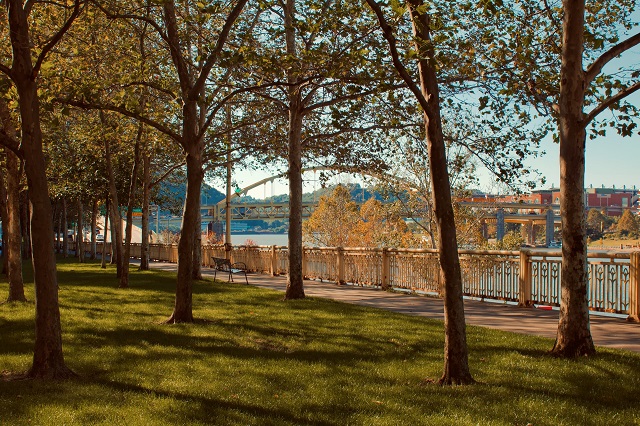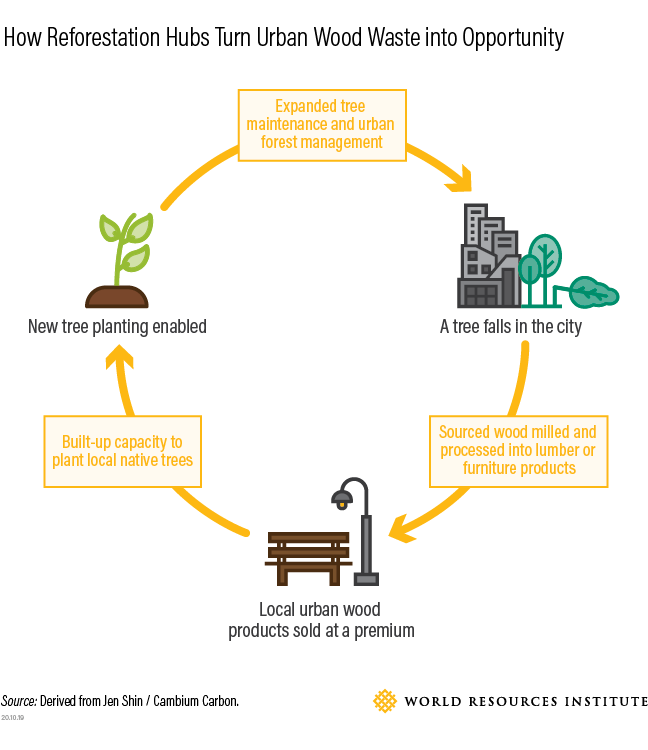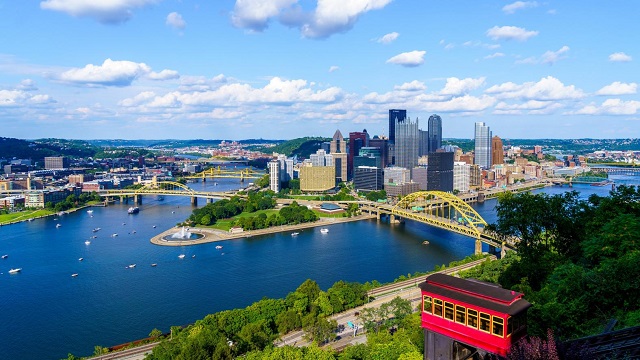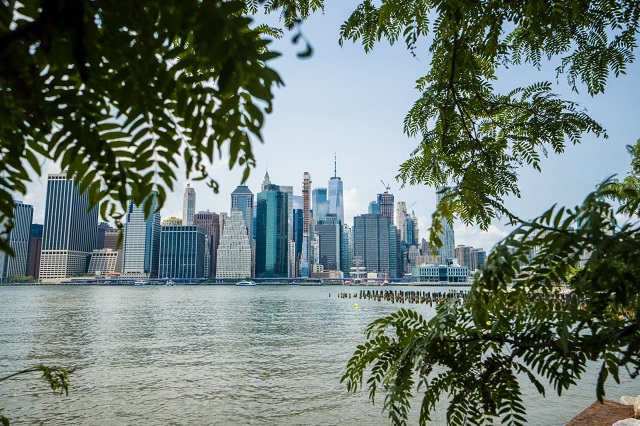
Imagine two trucks passing on a city street. One is a delivery truck carrying new wood flooring and furniture to stores and homes in the city. The other is carrying a fallen city tree damaged by a recent storm, taking it out of town to be mulched, burned or sent to a landfill.
This scenario plays out every day in urban communities around the world and represents a huge, missed opportunity for cities, consumers and the climate. Trees offer various benefits for cities, yet 36 million trees come down in cities across the United States each year due to disease, development or old age. Much of this wood ends up burned, chipped into mulch or tossed into landfills, despite its potential to become a valuable product.
The “reforestation hubs” model allows cities to create new value from fallen urban trees. Rather than continuing business-as-usual urban wood waste, cities can help recover and “upcycle” that waste into higher-value products such furniture, flooring and construction material. The revenue that is generated from the sale of those items and the reduced cost of wood waste disposal can then funnel back into urban forestry projects, such as planting new trees or maintaining existing trees.

New case studies by Cambium Carbon and the Arbor Day Foundation show that there is a substantial urban wood re-use opportunity in three major U.S. cities that are part of the Cities4Forests network. If cities seize the opportunity to build a wood reuse market, they can save money, provide new resources for urban forest restoration and see significant climate benefits.
Salvaging Wood Waste from Pittsburgh

Nested along steep hillsides prone to erosion, Pittsburgh, Pennsylvania, is on a mission to restore its degraded landscapes. The city hopes to plant 100,000 trees by 2030 and combat a 6.2% tree canopy decline from 2010 to 2015.
Pittsburgh’s tree loss has impacted the city in various ways. In 2020 alone, Pittsburgh removed more than 1,300 trees from public land at a cost of roughly $27 per ton for contracted disposal. Trees are typically removed in two- to three-foot sections, with smaller-diameter limbs and brush ground up for mulch, compost or boiler fuel. This process releases the carbon stored in trees back into the atmosphere. And in addition to the cost of disposal, the city loses an estimated $250,000 annually from the unrealized economic value of the material.
Wood waste utilization presents an opportunity for the city to cut costs, meet its urban forestry goal and increase material efficiency. The study identifies opportunities for the city to use its wood waste stream to make products necessary for new planting, such as tree stakes or mulch. While the city’s current contract for wood waste management entitles it to a portion of finished mulch or compost, very little of that material is claimed in practice. This is due to gaps in communication between disposal and new procurement, as well as existing mulch not being ground to the specifications required for reuse. Returning the city’s own wood waste to the landscape can not only advance zero waste initiatives, but help the city avoid new procurement costs. This would free up the critical urban forestry budget needed to care for and restore the city’s tree canopy.
Catalyzing a Wood Waste Economy in Eugene

Eugene, Oregon’s rich legacy as a regional center for forest product manufacturing provides a unique opportunity for the city to create a commercial market for salvaged wood and get fallen logs into the hands of local processors. The city removed roughly 1,000 trees in 2020, which contained as much as 50,000 board feet of merchantable wood. That’s enough material to stretch a whole mile long and almost ten feet across with one-inch slabs of wood. At the same time, the team behind the study identified 76 wood millers, secondary wood product manufacturers and potential buyers in the area who could make a market from this wood.
Cities need fixed infrastructure to process and up-cycle urban wood. Therefore, the study recommends using a shared sorting yard to aggregate logs from sources such as city crews, tree care companies and the local electric utility. In turn, a public-private partnership — such as a model pioneered in Eau Claire, Wisconsin by the nonprofit Wisconsin Urban Wood — could enable local sawyers and millers to utilize and process the material through their existing facilities. Eugene’s legacy as a logging town also offers the private sector capacity and critical expertise needed to mill, dry and sell recycled wood as products such as tables, furniture or flooring. This makes a compelling case for the city to collaborate with local artisans and manufacturers, rather than oversee its own processing infrastructure.
Centralizing New York City’s Wood Waste Processing

Between 2015 and 2020, New York City removed an average of over 12,000 street and park trees each year. Most tree material was chipped on site, allowing for easier transportation and disposal outside of the congested urban environment. The city also has a decentralized urban forestry system in which each of the five boroughs operates its own forestry team. This largely siloed approach makes it even more complicated to manage a massive wood waste stream.
Waste management costs also pose a major challenge. With real estate and transit at a premium, the cost to have wood waste hauled and disposed — known as a “tipping fee” — can be up to $70 a ton. These costs can be significantly increased after severe storm events: 2020’s Hurricane Isaias downed nearly 3,400 trees in New York City parks, leading to a bill of more than $1.5 million for the city’s wood waste management that year.
The case study found that establishing a centralized sorting and processing operation to recycle fallen wood from Brooklyn and Queens alone could provide a net present value of $7 million over 10 years in addition to savings from avoided disposal fees. A reuse program within the city could also avoid significant transportation and disposal emissions, as the city would no longer have to truck waste outside of the city and state. Additionally, local processing would allow for carbon storage in durable wood products, much of which would otherwise be released during burning, mulching and decomposition. In addition to reduced transportation emissions, the study estimates that over 10,000 metric tons of CO2 emissions can be reduced through a pilot wood reuse program through carbon storage alone.
Scaling the Urban Wood Opportunity
The urban wood opportunity is not limited to these three cities. While specific wood waste management strategies will vary according to local context, these new assessments can help identify best practices for peer cities looking to make the most of their fallen trees.
For example, cities can create unified asset management systems for tree data. All three cities had an issue with fragmented information management, as various agencies (such as planning and zoning, public works, and branches of parks and recreation) kept separate tree records. As a result, tree removals were not measured or managed in a cohesive fashion. Other cities may be able to establish centralized log collection infrastructure, as pioneered by the City of Baltimore. Other cities, including members of Cities4Forests, may wish to revise policies, such as setting new contractor requirements for disposal or establishing a local preference for city procurement.
Regardless of next steps, one thing is clear: cities have a lot to gain from seizing the value of their fallen trees. While these case studies provide three models for wood reuse, it’s up to government leaders across the nation to develop full life cycle management strategies for city trees and discover how reforestation hubs can benefit their communities.
Read the full assessment to learn more about the urban wood opportunity or follow the progress of leading cities working to turn wood waste into opportunity.
This article originally appeared on WRI’s Insights.
Marisa Repka is the Co-Founder & CFO of Cambium Carbon, a public benefit corporation working to build a circular economy model for wood reuse. Learn more here.
James Anderson is an Associate II for the Natural Infrastructure Initiative at World Resources Institute.






